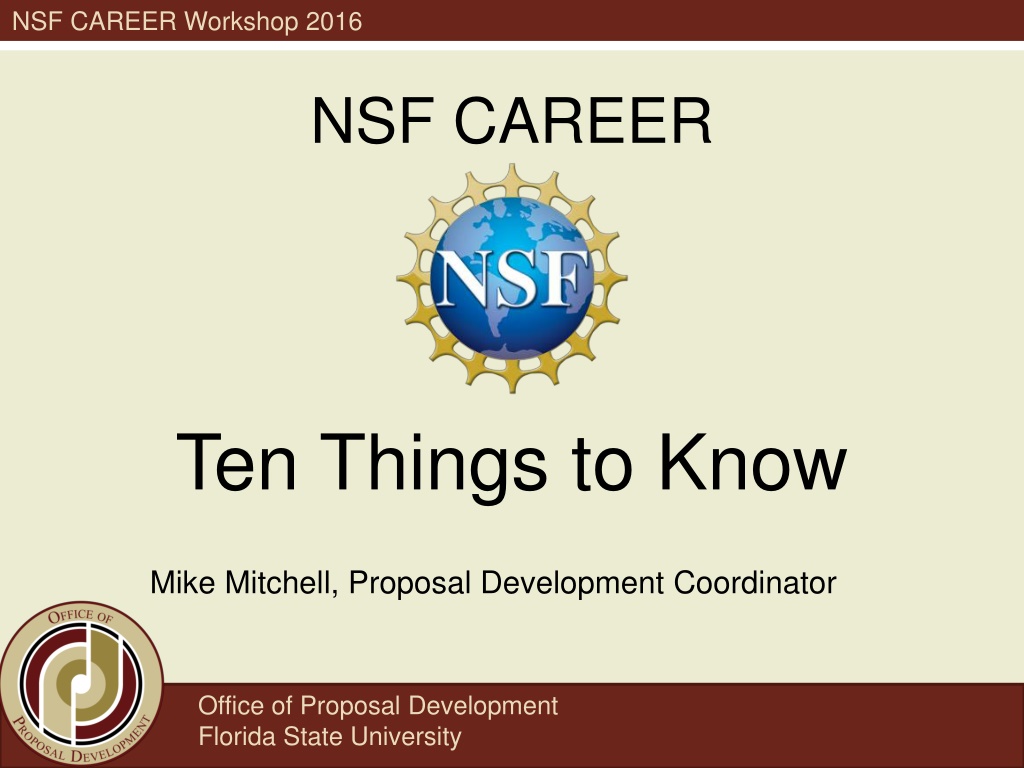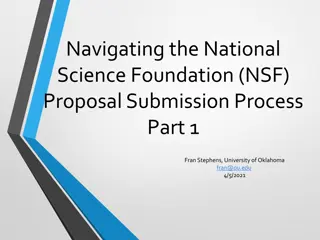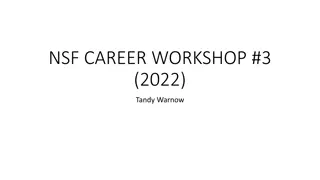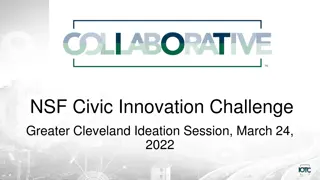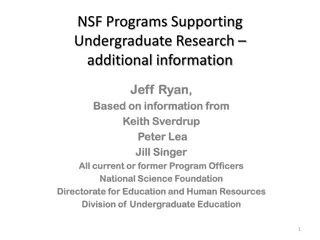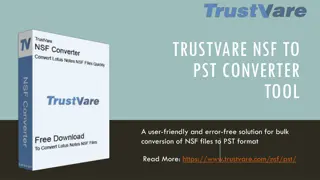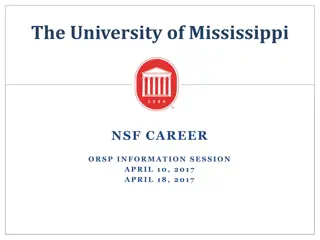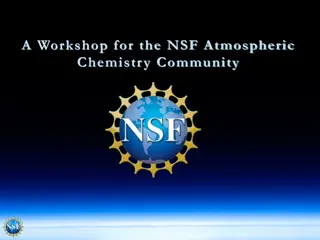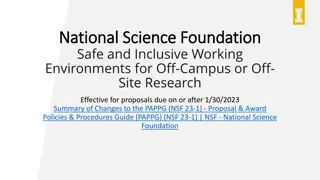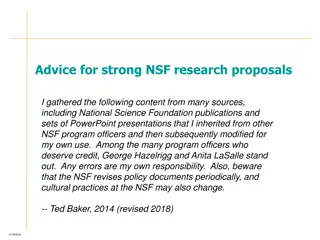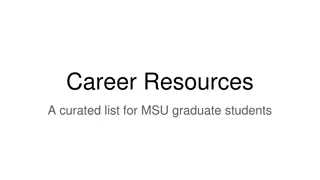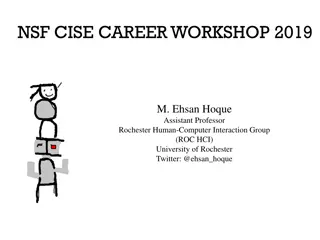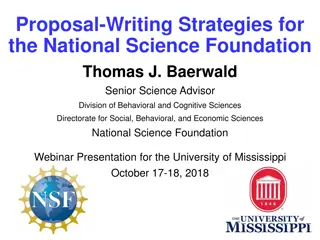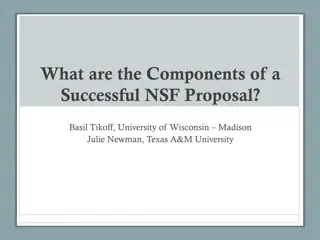Essential Tips for NSF CAREER Proposal Success
Learn key insights from NSF CAREER Workshop 2016 on maximizing your proposal's impact. Discover the importance of focusing on your career development, integrating research and education components effectively, collaborating with senior faculty mentors, and setting SMART goals for success.
Uploaded on Mar 01, 2025 | 0 Views
Download Presentation

Please find below an Image/Link to download the presentation.
The content on the website is provided AS IS for your information and personal use only. It may not be sold, licensed, or shared on other websites without obtaining consent from the author.If you encounter any issues during the download, it is possible that the publisher has removed the file from their server.
You are allowed to download the files provided on this website for personal or commercial use, subject to the condition that they are used lawfully. All files are the property of their respective owners.
The content on the website is provided AS IS for your information and personal use only. It may not be sold, licensed, or shared on other websites without obtaining consent from the author.
E N D
Presentation Transcript
NSF CAREER Workshop 2016 NSF CAREER Ten Things to Know Mike Mitchell, Proposal Development Coordinator Office of Proposal Development Florida State University
#1: CAREER is About YOU From Program Solicitation the National Science Foundation s most prestigious award in support of junior faculty who exemplify the role of teacher-scholars, through outstanding research, excellent education, and the integration of research and education Such activities should build a firm foundation for a lifetime of leadership in integrating education and research Translation: The focus of this grant is on you, and your contributions to science and education. NSF wants to invest in the most promising junior faculty who have the highest potential to contribute to their field, throughout their careers. Your proposal needs to sell them on why YOU are among the most promising junior faculty, your research and education plans are innovative, and how this award will set you up for a lifetime of contributions. Career development plan, not just a research proposal. Office of Proposal Development Florida State University
#2: Integrate the Research and Education Components NSF CAREER supports teacher-scholars Do not neglect the education component, and be creative with it. No canned answers or generic plans. Think about how the research and education components impact each other, i.e. how will research results influence the educational aspect? How will you measure the impact/success of the educational component? Office of Proposal Development Florida State University
#2: Integration of Research and Education Good: The dynamical robots used in this study will also be used as part of a new program Robots and Rovers: Getting a Leg Up to connect the robotics community in the Tallahassee area. This program will connect university students both in person and through online social networks to members of the local maker community, to high-school participants in the FIRST program, and to students in over a dozen local middle and elementary schools. Bad: The PI will work with students at a local high school to describe the results of the research. Office of Proposal Development Florida State University
#3: Work with Your Senior Faculty Mentor They know your field, know your research, and know YOU Are invested in your success Most likely have successful NSF experience, either as a reviewer or awardee, or both Office of Proposal Development Florida State University
#4: Be SMART Specific: Clear and focused to avoid misinterpretation. Should include assumptions and definitions and be easily interpreted. Measurable: Can be quantified and compared to other data. It should allow for meaningful statistical analysis. Attainable: achievable, reasonable, and possible under conditions expected (i.e. budget and timeframe). Relevant: Fits with NSF s, FSU s, and your own career and research goals. Timely: The work is doable within the performance period of the award. Office of Proposal Development Florida State University
#4: Be SMART SMART: This project will conduct a statewide survey of 1,047 mathematics teachers and 35,304 students in 6th through 8th grades in 201 middle schools, and case studies of eight middle schools in Missouri to address the following research and educational objectives: 1) examine the nature of mathematics teachers opportunity to learn for instructional improvement, 2) examine how work contexts influence the quality of teacher learning opportunities, 3) examine the impact of teacher learning opportunities on changes in student mathematics achievement over four years, and 4) work with district and school administrators to promote instructional improvement and student achievement by effectively providing learning opportunities to mathematics teachers. Office of Proposal Development Florida State University
#4: Be SMART Not SMART: This project will examine middle and high school teachers to see how they learn, what influences their teaching, and will use the results to help them be better at their jobs. Office of Proposal Development Florida State University
#5: Contact your NSF Program Officer NSF Program Officers expect you to do this Email a 1-page briefing on yourself and proposed topic, including intellectual merits and broader impacts. Ask for advice on whether this fits their directorates mission, or if it should go somewhere else. Be specific in your email, make sure there is an ask Don t cold call or pester them Office of Proposal Development Florida State University
#6: Know the Review Criteria Review Criteria from Program Solicitation: 1. What is the potential for the proposed activity to Advance knowledge and understanding within its own field or across different fields (Intellectual Merit); and Benefit society or advance desired societal outcomes (Broader Impacts)? 2. To what extent do the proposed activities suggest and explore creative, original, or potentially transformative concepts? 3. Is the plan for carrying out the proposed activities well-reasoned, well-organized, and based on a sound rationale? Does the plan incorporate a mechanism to assess success? 4. How well qualified is the individual, team, or organization to conduct the proposed activities? 5. Are there adequate resources available to the PI (either at the home organization or through collaborations) to carry out the proposed activities? Office of Proposal Development Florida State University
#6: Know the Review Criteria Reviewers also must consider: 1. The Departmental Letter 1. Should demonstrate an understanding of, and commitment to, the effective integration of research and education as a primary objective of the proposed CAREER award 2. Must establish how the institution (department) will commit to professional development and mentoring of the PI 3. Certify that PI is eligible for CAREER 2. Data Management Plan 3. Post-Doc Mentoring Plan (if applicable) Office of Proposal Development Florida State University
#6a: Make sure a reviewer can answer : Who are you, and what do you want to do? Why do you want to do it, and why should we care? How will you do it? How will you know if you are successful? What benefits will accrue if you are successful? Are you qualified, and do you have the resources necessary, to be successful? Office of Proposal Development Florida State University
#7: Follow the Required Proposal Format NSF Grant Proposal Guide (GPG) and Program Solicitation 15-555 Program Solicitation takes precedence if conflicts New GPG released January 2016 Refer to Summary of Significant Changes on OPD website Intellectual Merit and Broader Impacts are required to be separate, labeled, sections within the Project Description Refer to NSF CAREER Proposal Contents Checklist Part of NSF CAREER Toolkit Goes into specific detail about requirements of each section of the proposal, including FSU requirements. Office of Proposal Development Florida State University
CAREER Proposal Elements FSU Proposal Transmittal Form Cover Sheet Project Summary Table of Contents (generated automatically) Project Description (15 pages) References Cited Biographical Sketch of PI Budget and Budget Justification Current and Pending Support Facilities, Equipment, and Other Resources Additional Supplementary Documents Departmental Letter Letters of Collaboration Data Management Plan Post-Doc Mentoring Plan (if applicable) Office of Proposal Development Florida State University
#8: If You Are Rejected You are allowed three attempts at CAREER Many proposals are not funded on first or even second attempt Remember why you are doing this Secure funding for 5 years Will go a long way in your effort for tenure Read your comments Focus on recurring themes, not individual comments Think about what you can change Get to work on next year s proposal Office of Proposal Development Florida State University
#9: DO NOT DO THESE THINGS Don t list any Co-PIs or Senior Personnel Don t provide letters of support Letters of Collaboration must follow very specific format Don t include any appendices Don t duplicate another NSF award/proposal Don t use URLs in the Project Summary or Description Don t deviate from the solicitation or GPG Don t start writing your proposal in July Office of Proposal Development Florida State University
#10: Plan Around These Dates Today: Decide if you are applying for CAREER this year Next Week: Finalize your idea, and write a 1 page briefing on you, and your proposed topic, decide what Directorate Sometime in March: Email the NSF Program Officer Beginning of May: Project Description First Draft Completed Ask senior faculty/ subject expert and OPD to review Beginning of June: Start assembling required documents Departmental Letter, Budget, Letters or Collaboration, Biosketch, etc Beginning of July: Project Description Final Draft July 23rd: Proposals due to SRA Full proposal package (all required documents) due to SRA Can edit Project Summary and Project Description until NSF Deadline July 27th: Proposals due to NSF Refer to NSF 20-525 for specific directorate due dates Office of Proposal Development Florida State University
Mike Mitchell Proposal Development Coordinator 850-644-9511 mike.mitchell@fsu.edu Office of Proposal Development Office of Proposal Development Florida State University Florida State University
